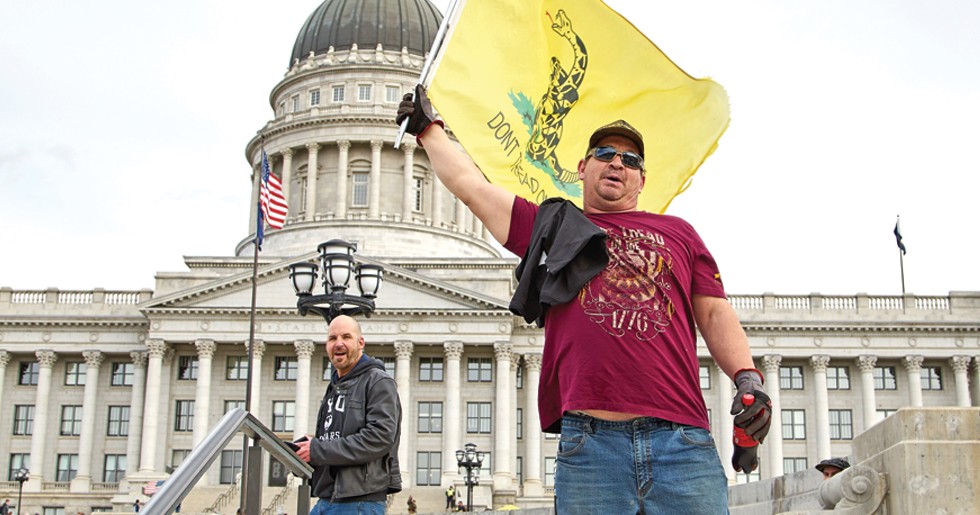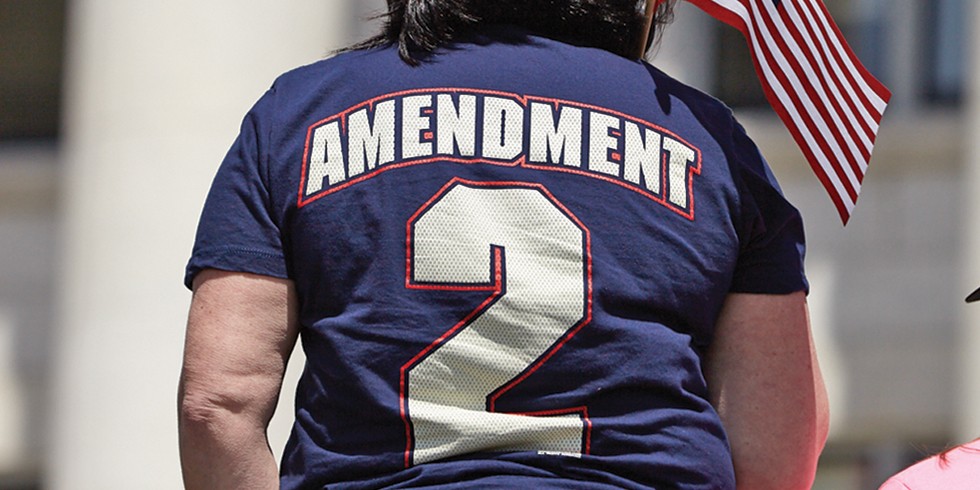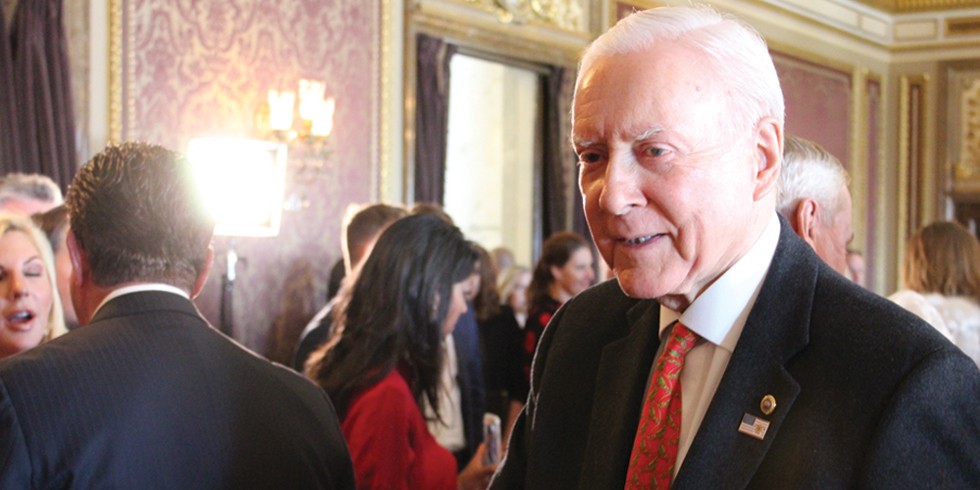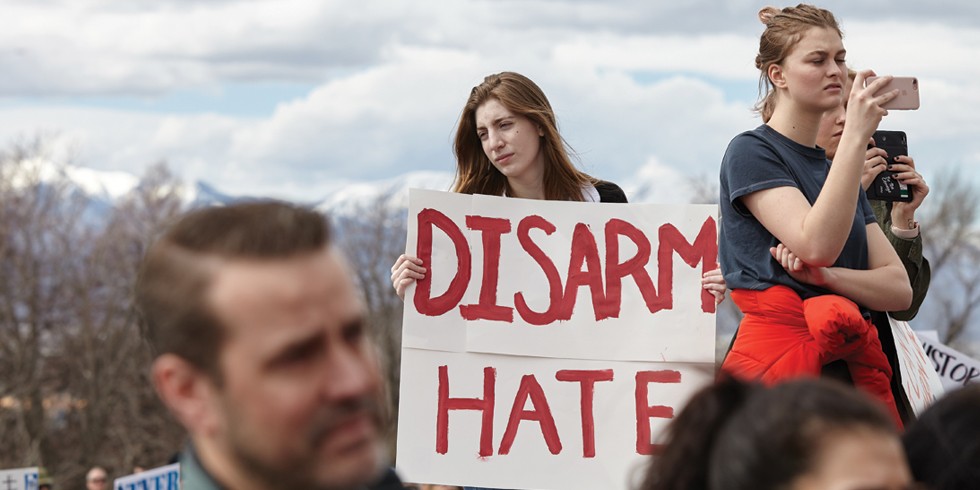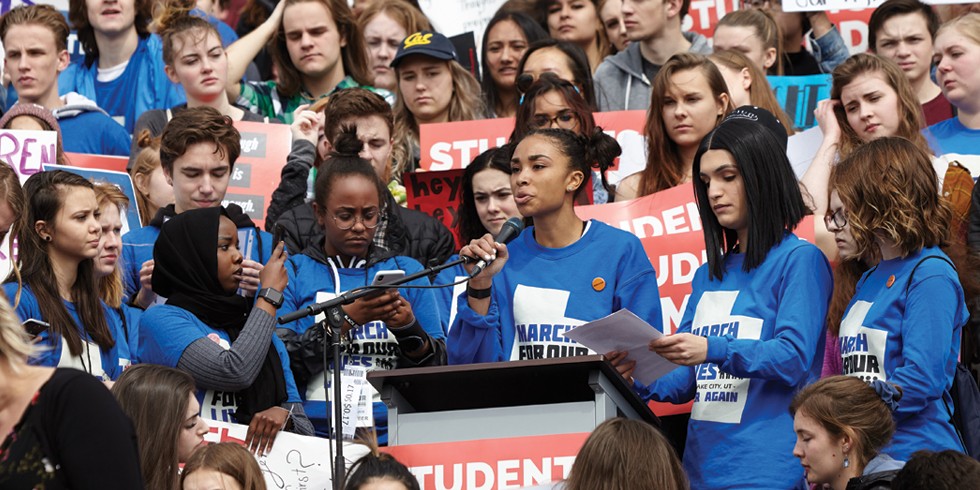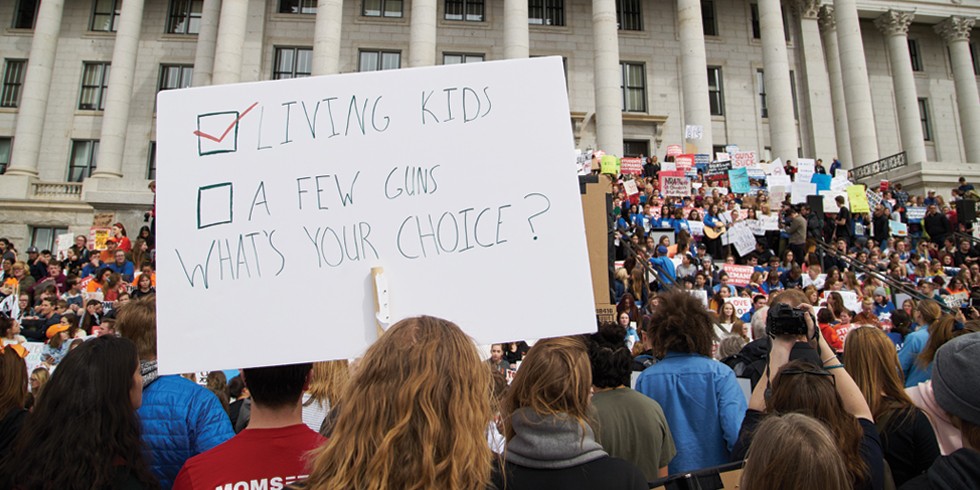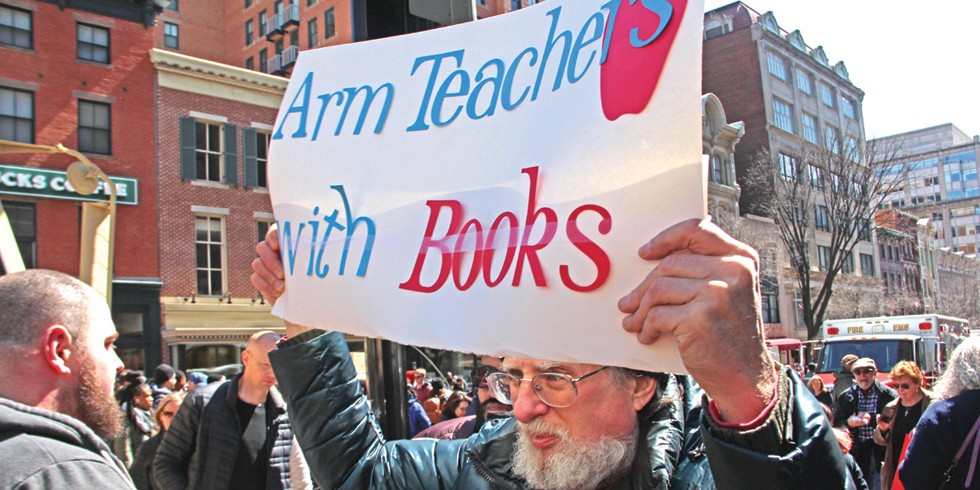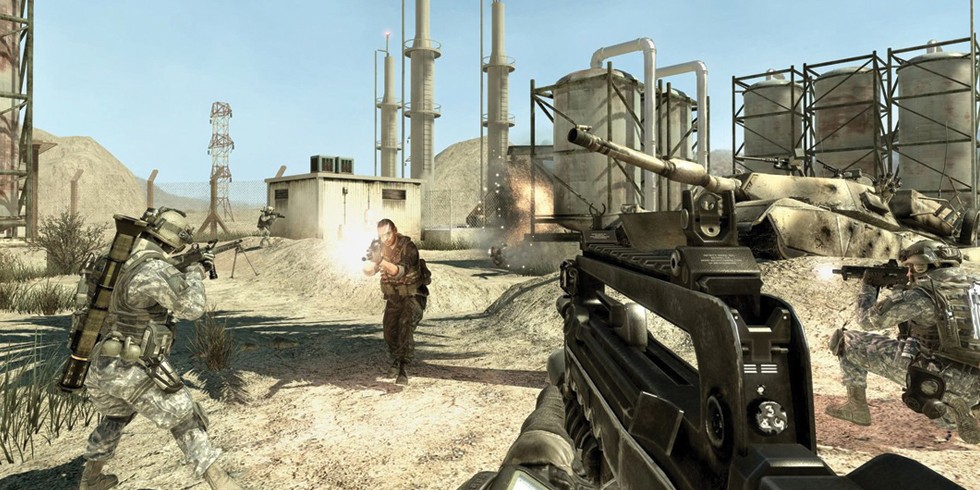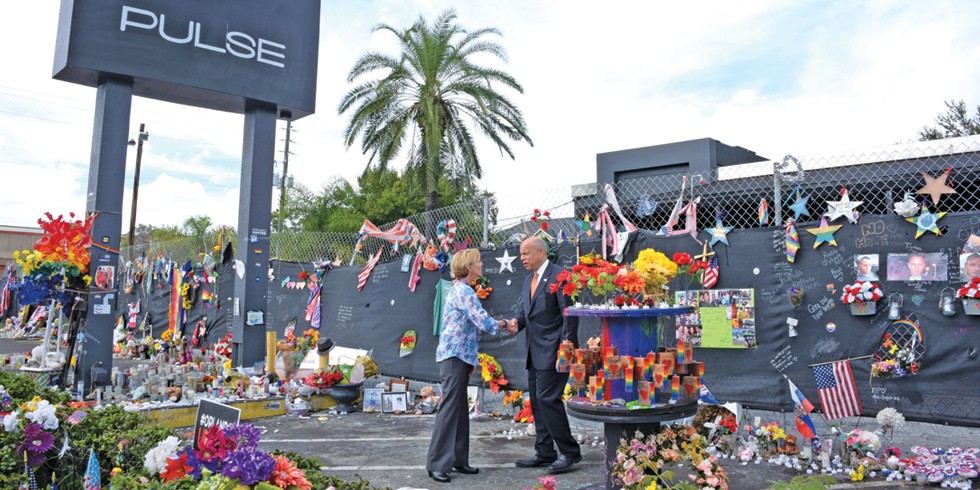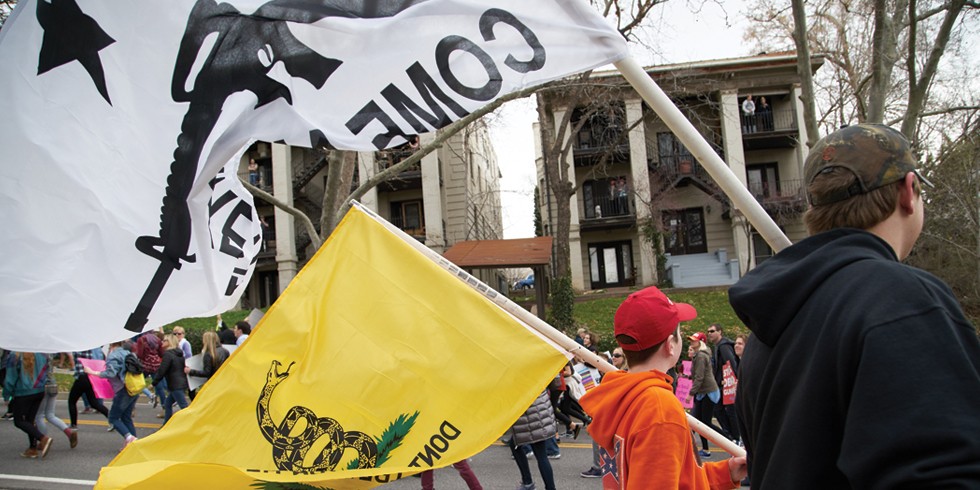Year
First the good news: America, overall, is a much less violent place than it used to be. Our reported violent-crime rate is almost half what it was in 1991. The bad? Mass shootings haven't decreased. In fact, they've become even deadlier.
In 2010, the World Health Organization found that the United States' gun-homicide rates were more than 25 times higher than in any other high-income country.
That was before Las Vegas. And before Parkland, Fla. During the past decade, we've witnessed 19 of the 30 deadliest mass shootings in modern U.S. history.
And it isn't just about murders. The suicide rate has been skyrocketing as well, reaching a 30-year high in 2016. More than half of those suicides were with firearms.
Today, high school and middle-school students across the nation, including here in Salt Lake City, have risen up in protests and marches after the Parkland shooting, demanding that something be done.
So now what?
We looked at 47 ideas to reduce gun violence, weighing the results of academic research and the analysis of experts.
Some ideas are good—they have a decent shot at saving lives. Some are messy, with the potential benefits weighed down by potential costs. Some are ineffective; doing little to nothing to combat gun violence. And some are just plain ugly—more likely to result in more death and injury, rather than less.
THE GOOD
Proposals likely to reduce gun violence and save lives:
1. PLUG HOLES IN THE BACKGROUND-CHECK SYSTEM
Gaps in the federal background-check system (the National Instant Criminal Background Check System) allow domestic abusers, convicted felons and people with mental illness to purchase guns.
Roughly 20 percent of Americans purchase guns without a background check. A 2013 survey of prisoners locked up for gun violence found that more than 96 percent of offenders who were legally prohibited from owning guns purchased them without a background check.
Experts point to three major holes:
1. In most states, gun buyers are able to purchase guns from unlicensed dealers who aren't required to run a background check at all. Some states, including Utah, require retail gun dealers to conduct background checks. However, Utah law also allows for individual citizens to buy and sell firearms without conducting a background check. After Missouri, for example, stopped requiring background checks for all firearm purchases, researchers found a 25 percent increase in firearm homicides.
2. If the FBI doesn't complete a background check in three business days, licensed dealers are free to sell the gun anyway. This is how the man who killed nine parishioners inside a black church in Charleston, S.C., bought a gun.
FBI data indicates that authorities failed to meet the three-day deadline 1.1 million times between 2014 and 2017. However, it's unclear how many firearms were actually sold because dealers have discretion to wait until the check is completed.
3. The federal definition of "domestic abuser" doesn't include unmarried or childless couples. Many states have closed the so-called "Boyfriend Loophole."
Strengthening the federal background-check system is one of the most feasible and most effective measures to reduce gun violence, surveys and research show. Statistics from the Centers for Disease Control and Prevention show that states requiring universal background checks have lower gun-death rates. Surveys show overwhelming public support.
2. LET AMERICANS SUE GUN MANUFACTURERS AGAIN
It's the American way: If a product is killing an unbelievable number of people, the proper remedy is to sue the hell out of them. This, after all, was the plot of the 2003 movie adaptation of John Grisham's Runaway Jury.
But since 2005, the Protection of Lawful Commerce in Arms Act made gun manufacturers and dealers essentially legally bulletproof.
A victim can still sue if a gun, for example, malfunctions and explodes—but not if a teenager uses it to kill 14 of his classmates. Guns are meant to kill, the Republican argument went, so why should people be able to sue when the gun has done what it was built to do?
Remove the shield, a recent op-ed in The New York Times pointed out, and that means gun manufacturers suddenly would have a financial incentive, like every other industry, to make their products safer—likely preventing more accidental shootings. While Democrats have repeatedly tried to push legislation to disarm the gun industry's special shield, it doesn't have a chance while Republicans are in control.
3. LIFT THE BAN ON GUN-CONTROL RESEARCH
From 2004 to 2014, gun violence killed about as many people as life-threatening infections known as sepsis, but funding for gun violence research was only about 0.7 percent of the amount spent to study sepsis, according to a 2017 research letter in the Journal of the American Medical Association. In fact, the researchers found that gun violence was the least researched cause of death, in relation to mortality rate. Only research into deaths by falling are funded less.
The nonpartisan RAND Corporation looked at thousands of U.S. gun-control studies and found that, in many areas, there just wasn't enough research to definitively show effects one way or another. The lack of research in certain areas muddles debates over policies, like some listed in this story.
Part of what has stymied gun research in the U.S. is the 1996 "Dickey Amendment," which prevents the Centers for Disease Control and Prevention from spending money on activities that "advocate or promote gun control." Former Arkansas Republican Rep. Jay Dickey, the amendment's namesake, told NPR he never intended for the amendment to cut off federal gun research altogether, only gun-control advocacy, and regrets that the effect was to essentially halt research in the area.
In March, President Donald Trump signed a spending bill that left the Dickey Amendment in place but clarifies that the CDC can research the causes of gun violence. It's not clear yet if federal research will increase, though, as no funding for gun-violence research was included.
4. COPY THE AUSSIES
It's considered perhaps one of the most successful gun-control programs in history. Barack Obama and Hillary Clinton have both pointed to Australia as a model of how dramatic gun control can make a nation safer. It's also about as close to "taking your guns" as the mainstream gun-control movement gets.
Here are the simple facts: There were 13 mass shootings in 18 years before Australia's sweeping National Firearms Agreement in 1997. In the following 20 years, there's been just one. While skeptics quibble with whether the law can be entirely credited, the country's already-low firearm-homicide rate fell further—and suicides absolutely plunged.
The flashiest piece of the program featured a mandatory buyback program that gathered around 650,000 firearms—a full fifth of the country's arsenal. However, today Australia has about as many guns as before the buyback.
Instead, the key, as the Science Vs. podcast explains, seemed to be the thicket of other laws that came with it, including a ban on semi-automatic and pump-action rifles and shotguns. You have to show a good reason to own a gun—and self-defense doesn't count. You can only sell through a licensed dealer. You have to register your gun and report it if it's stolen.
Much of the Australia program would also almost certainly be struck down by the Supreme Court—and the cultural and physical geography of the United States would create serious regulatory challenges. But even some pieces of Australia's gun-control program, when combined, could seriously reduce deaths.
5. TRACK GUNS—AND MANDATE REPORTING IF THEY'RE STOLEN
One of the most effective parts of Australia's gun-control strategy was simply creating a gun registry—and then enforcing it. In the United States, gun-rights activists fear registries are only the first step to confiscation—and research on their effectiveness in the U.S. is limited.
Yet, the potential benefits are clear, particularly when combined with a requirement that lost or stolen guns are reported: It's a way to close the loophole of "straw purchasers"—where a person illegally buys a gun for somebody else ineligible to purchase one. It hands law enforcement officers the ability to actually identify which guns are stolen—cracking down on both illicit arms traders and allowing cops to get convictions for thieves. And it encourages gun owners to do a better job of safely securing their weapons.
A 2002 report from the Bureau of Alcohol, Tobacco and Firearms concluded that about 85 percent of criminal gun owners weren't the original purchaser of their gun. So if you're worried about stopping a bad guy with a gun—make sure he doesn't get one in the first place.
6. INSTITUTE BACKGROUND CHECKS AND TRACKING FOR AMMUNITION
Only a handful of states currently have laws regulating the purchase of ammunition. Federal law does not currently require ammo purchasers to submit to a background check.
This year, congressional Democrats introduced a bill that would establish a federal background check system for ammo. U.S. Rep. Debbie Wasserman Schultz, D-Florida, one of the sponsors of the bill, has said it would plug an "absurd loophole" that allows people to "amass hundreds of rounds of ammunition without so much as sharing their first name with a gun store clerk."
Starting in 2019, California will require ammo vendors to report bullet sales to the state's Department of Justice and conduct background checks on ammunition sales. New York and New Jersey have similar laws.
While the NRA has opposed such proposals, a 2013 Fox News poll found 80 percent of respondents were in favor of ammunition background checks.
And a study in the journal Injury Prevention analyzing school shootings between 2013 and 2015 found that states with ammunition background checks (along with other factors) have lower rates of school shooting incidents.
7. BAN HIGH-CAPACITY MAGAZINES
To trained hands, reloading a weapon is second nature, like wiping your brow or cracking your knuckles. The rounds run out, the bolt slams forward, the magazine drops with a simple push of a finger and a new magazine is inserted. It only takes a few seconds.
But in a mass shooting, those seconds can buy people time to get to safety—or disarm the shooter. At Seattle Pacific University in 2014, an unarmed student used pepper spray to subdue a shooter while he was reloading.
And as advocates of high-capacity magazine bans point out, you wouldn't need more than 10 rounds before reloading to kill a deer.
High-capacity magazines and the weapons capable of bearing them, including handguns, were disproportionately recovered by police in connection with violent crimes in Baltimore, Minneapolis and Richmond. These same types of magazines were used in the 2017 Las Vegas shooting. Ultimately, reducing the number of rounds that can be shot from any weapon will reduce its lethality.
8. MAKE FIREARM OWNERS LOCK 'EM UP
An eighth-grade school shooter in Townville, S.C., The Washington Post reported, thought he'd be able to kill at least 50 of his classmates—150 if he got lucky. But he couldn't get into the gun safe where he thought his dad kept the powerful Ruger Mini-14 semi-automatic rifle. Instead, he settled for a pistol he found in his dad's dresser—a pistol that jammed after he shot several elementary school students. He didn't notice that the rifle hadn't actually been locked up either.
More than two-thirds of school shooters got their guns from their own homes or homes of relatives.
Massachusetts legally requires guns to be either kept in locked containers or protected with a trigger lock that prevents them from being fired. Gun-rights advocates strenuously objected, arguing that locking up their firearms made it nearly impossible to ward off a home invader.
But a 2015 Harvard University analysis found that victims using guns to ward off criminals were more likely to be injured than people who just tried to run away. By contrast, other studies have found that safe storage practices significantly reduce the risk of suicide and accidental gun deaths. Not only that, it makes it harder for thieves to steal them during a burglary.
If you don't want the outlaws to get guns, in other words, outlaw leaving guns where outlaws can get them.
9. PUSH DOCTORS TO TALK TO PATIENTS ABOUT GUNS
Before the Parkland shooting, Florida was such a pro-gun state that it actually passed a law restricting doctors' abilities to ask their patients about gun ownership. (The 11th Circuit Court of Appeals struck it down last year.)
That flies in the face of recommendations from the American Medical Association and the American Academy of Pediatrics, both of which recommend doctors discuss guns with their patients to prevent accidental shootings and suicides. So far, the research on the effectiveness of doctors talking with patients about guns is limited and mixed, but it does seem to improve patients' use of safe storage devices, especially when doctors actually give out the devices.
Not only that, but one 2000 American Academy of Child and Adolescent Psychiatry study found that after counseling from a psychiatrist, a third of the parents of suicidal teens removed firearms from their homes. With suicide, by far, the leading cause of deaths from firearms—that's a big deal.
10. BAN BUMP STOCKS
When a mass shooter fires into a crowd with a semi-automatic rifle, how fast he can pull the trigger becomes a life-or-death question. In the Las Vegas shooting last October, the gunman in the Mandalay Bay Hotel room was able to fire nine rounds per second. That's all thanks to a rifle modification called a bump stock, which harnesses the recoil of a weapon to allow a shooter to fire at speeds comparable to already illegal automatic weapons.
After Las Vegas, banning bump stocks has become a rare gun-control measure even Republicans in Congress say they support—though not, so far, enough to actually pass federal legislation to ban them.
But the impact would likely be small. While fewer people might have died in Las Vegas if bump stocks were banned, the devices have rarely, if ever, been used in prior shootings.
11. RAISE THE FIREARM-PURCHASING AGE
Check out this absurdity: You can't buy a handgun from a licensed dealer if you're under 21. But if you're 18, you can buy an AR-15.
While Republicans like State Sen. Orrin Hatch remain wishy-washy on the subject ("We'll have to look at that. That's not something you just shove aside," he said during a February interview), after the Parkland shooting, even gun-rights-loving Florida passed a bill that hiked the age to 21. (Utah law provides that no person under age 18 may possess a handgun, sawed-off rifle, sawed-off shotgun or fully automatic weapon unless he or she: Has the permission of one's parent or guardian to have the weapon; or is accompanied by a parent or guardian while in possession of the gun.)
The proposed reform is unlikely to have a dramatic impact on mass shootings, however: Out of the 156 mass shootings since 2009, a Vox piece explained, only one was committed by a gunman under age of 21 with a legally purchased semi-automatic rifle. So gun-control advocates suggest going further: Raise the legal age for unlicensed dealers as well, barring informal gun-sellers—dealers at gun shows, for instance—and online stores from selling handguns and rifles. Heck, raise it to 25. Treat guns as seriously as rental cars. FBI data shows that more than half of firearm-homicide offenders from 2005 to 2015 were under age 25.
12. GIVE COPS THE POWER TO RESPOND TO RED FLAGS
The horror of the Parkland shooting was compounded by the fact that so many people knew that the shooter was a danger. Why didn't anyone take away his weapons? They legally couldn't. All the red flags in the world can't do much if the cops don't have a legal right to act on them.
It's caused a number of states to enact "red flag" laws, giving cops the power to ask a court for a warrant to temporarily remove a person's access to firearms if they're an imminent danger to themselves or others.
In the 14 years after Connecticut implemented such a law in 1999, police temporarily removed an average of seven firearms from each at-risk gun owner across 762 firearm-removal cases, one study found. Often, those gun owners were connected with mental-health treatment they wouldn't have received otherwise. Ultimately, more than 100 suicides could have been prevented, the study estimated.
13. LET FAMILY MEMBERS PETITION FOR GUN REMOVALS
The profile of mass shooters can vary radically, but a few things keep popping up: They're almost always men. And they very often have a history of domestic violence. In fact, more than half of the shootings from 2009 to 2016 tallied by Everytown For Gun Safety involved domestic or family violence.
It's scary as hell to be a woman trapped in a violent relationship—it's even scarier if he can kill you with the click of a trigger. It's why some states have adopted the use of Gun Violence Restraining Orders.
Red-flag laws in states like California and Washington let family members, friends and employers—not just a police officer—ask a court to temporarily take away a person's firearm access.
14. ALERT THE COPS WHEN SOMEONE FAILS A GUN BACKGROUND CHECK
Here's a policy both Florida Republican Sen. Marco Rubio and his counterpart Democratic Sen. Bill Nelson support: Federal officials are required to notify local authorities within 24 hours whenever someone tries to buy a gun, but fails the National Instant Criminal Background Check System.
Last year, Washington state passed a similar bill—requiring gun dealers to report a failed background check. A KING 5 report found that there were almost 4,000 instances of failed backgrounds checks per year in Washington state, but police were doing little to follow up to find out why ineligible buyers were trying to purchase weapons. It's a minor fix, but since authorities often miss multiple red flags before mass shootings, this would at least make the red flags shine a little brighter.
15. REQUIRE STATES TO SHARE MENTAL-HEALTH RECORDS WITH THE FEDS
Technically, federal law already prohibits people with a history of some mental-health conditions from possessing guns. But the FBI's federal background check system relies on states voluntarily reporting that information, and participation is spotty. A New York Times report in 2016 found that Pennsylvania had entered more than 718,000 mental records (5,618 per 100,000 residents) into the federal background check system, for example, while Montana had entered in a grand total of four. Utah, meanwhile, submitted 8,240 records—about 280 per every 100,000 residents.
There are legitimate debates about which mental-health conditions should exclude a person from gun ownership; the vast majority of people with mental-health conditions, after all, are not violent. But as it stands, some states failing to share their information or properly enforce the law has allowed dangerous individuals like the Virginia Tech shooter to gain access to guns. Recent bipartisan legislation has directed grant money to help states better share that information.
16. LET GUN OWNERS IN CRISIS TEMPORARILY SURRENDER THEIR WEAPONS
This legislative session, Washington State passed a first-of-its-kind law intended to prevent suicides. Citizens can now voluntarily waive their rights to own a gun by having their name added to a list of prohibited purchasers in the national background-check database.
The new law outlines a process to make sure identities aren't falsely added to the prohibited list, and also includes a way for people to restore their gun rights later.
Making it harder to access guns can stop suicides: About half of people who survived suicide attempts and were interviewed for studies said just a few minutes to half an hour passed between when they felt suicidal and when they attempted. Guns are more lethal than other suicide methods, leading to death more than 80 percent of the time.
Other means of voluntary gun surrender vary. Most law enforcement agencies and gun sellers are willing to temporarily store guns for people who are concerned their loved one is suicidal or worried about their gun being safely stored while they are away from home or have visitors over, according to a study published in the American Journal of Public Health in October 2017. About 75 percent of the 448 law enforcement agencies in the eight states surveyed in the study already provided some form of temporary storage.
17. REQUIRE A POLICE INTERVIEW TO GET A GUN
In 1911, New York passed the Sullivan Act. Richard Aborn, president of the Citizens Crime Commission of New York City, calls the act "possibly the most effective gun-control law in the history of the country," in an interview on Slate's podcast, The Gist.
In New York, it generally takes about six months to get a gun after the applications, background check, safety training and an interview with a uniformed NYPD officer, Aborn says. New York also requires safe storage and reporting if a gun is lost or stolen and bans large-capacity magazines and assault-style weapons.
"The goal is not to prevent law-abiding citizens from getting guns," Aborn says on the podcast. "But rather to make sure criminals didn't get a gun. And guess what? It works!"
Firearm death rates in New York are consistently among the lowest in the entire country. In 2016, CDC data shows a rate of 4.2 firearm deaths per 100,000 people, compared to say, Alaska's 23.3 or Utah's 12.9.
18. REQUIRE FIREARM OWNERS TAKE GUN-SAFETY CLASSES
In some countries, the checklist of what people need in order to buy a gun includes a requirement to take a gun-safety course and pass a test, demonstrate gun knowledge or get a membership at a shooting club or range.
In the United States, about 61 percent of gun owners have gotten some type of training, which typically included information about safe handling, storage and preventing accidents, according to a 2015 University of Washington study. But the study identified gaps in training: Only 15 percent of owners said they were trained about suicide prevention, and only 14 percent of those who lived with gun owners had received any safety training.
In countries that require some type of safety course (often coupled with other strict rules around gun ownership) such as Japan, the U.K. and India, the rate of gun deaths are significantly lower than those in the U.S.
And according to a new Johns Hopkins study, those who said a gun-safety course influenced their storage practices were more than twice as likely to store all their weapons in a locked manner as the general population.
19. LET COPS DESTROY SEIZED GUNS
More than a dozen weapons confiscated by Washington state law enforcement since 2010 later ended up as evidence in new crimes, according to an extensive Associated Press investigation.
Research shows that as gun ownership increases, so do gun homicides. With that in mind, the state law requiring the Washington State Patrol to sell or trade back to the public most of the guns it confiscates seems counterproductive. In fact, this legislative session WSP supported a bill that would have given them the option to destroy confiscated firearms. It didn't pass.
While some police chiefs wince at the idea of recirculating guns back to the public, others, such as Spokane Police Chief Craig Meidl, contend that the firearms sales are an essential source of income.
Utah lawmakers passed House Bill 252 in 2017 that created a state-sponsored sales channel for confiscated or unclaimed firearms. Prior to the bill's implementation, law enforcement agencies either sold the guns themselves or destroyed the firearms. The bill, which took effect this year, requires the Utah Department of Public Safety to contract with a federally licensed gun dealer. Any revenue from the state-sponsored sale goes toward non-profit agencies that help families of fallen officers.
However, the agency can still sell the guns themselves if it gets approval from its city or county governing body. They are also still permitted to destroy the guns if the agency deems it necessary. For example, if the weapon was used in a notorious crime or the gun is unfit to sell to the public, the firearm might be destroyed.
20. HELP GUNSHOT VICTIMS PREVENT BEING SHOT AGAIN
Start with the premise that violence begets violence. Research shows that people who have been shot and survived have a much higher chance of being shot again, but also of committing more crime.
Hospital intervention, then, aims to meet victims of violent, often gun-related injuries before they're released. Case workers offer services before victims walk out of the hospital (housing, education, transportation, treatment) and continue to follow up for months afterward.
These programs have been successful at reducing crime recidivism and some peer-reviewed research indicates the effects could be long-lasting, though more data is needed.
21. CONNECT SHOOTERS WITH THE COMMUNITY
Perhaps the most popular example of this is Boston's "Operation Ceasefire" in the 1990s, which is credited with a 63 percent reduction in youth homicide. The program brings together community members, social service workers and police with victims and perpetrators of gun violence and has shown success, particularly in cities with a small group of readily identifiable offenders.
The idea is for community members (clergy, victims, reformed offenders) to invite those responsible for gun violence to a face-to-face meeting. There, they send a clear message that the violence must stop and offer services (education, housing support, substance abuse and mental health treatment, tattoo removal).
Several cities plagued by gun violence have shown reductions in gun-related homicides and gang-related violence.
22. MANUFACTURE AND SELL SMART GUNS
A 2-year-old shot and killed his mother inside a Hayden, Idaho, Walmart in 2014. From the shopping cart, the toddler had reached inside the 29-year-old mother's purse, where she kept a concealed pistol. When we talk about smart guns, advocates often point to this example for support.
Smart guns are designed to restrict who can fire them. Some require an authorized fingerprint, others use a radio-controlled watch or other device that must be within a certain distance of the gun in order to fire. There are also trigger guards that require a fingerprint to unlock.
A small 2003 study of 117 unintentional and undetermined firearm-related deaths found that personalized firearms technology was among the most effective at reducing accidental deaths.
While the National Institute of Justice issued baseline requirements for smart guns at Obama's direction, so far, a relative lack of funding along with backlash from gun-rights proponents, including the NRA, has stifled smart guns' popularity. An NRA-led boycott of Smith & Wesson almost put the gun maker out of business after it pledged to research smart guns among other reforms.
23. REQUIRE GUNS WITH MAGAZINE SAFETIES OR CHAMBER INDICATORS
It's easy to forget there could be one in the chamber. That same 2003 study found that two gun-safety features designed to address the forgotten round in the chamber are also effective at reducing accidental deaths.
The first is known as a loaded-chamber indicator, which on some guns is a small pin that sticks up from the top. The second is a magazine safety, which disables the gun if the magazine is removed.
Still, accidental or unintentional firearm deaths only account for a fraction of total gun-related deaths in the U.S and have declined to 489 in 2015 from 824 in 1999, according to CDC data.
24. GIVE LOCAL GOVERNMENTS THE POWER TO REGULATE GUNS
Most states have laws broadly preventing local governments from regulating guns. Since the 1980s, prompted by the NRA and other gun-rights groups, at least 43 states have passed "preemption" laws, which advocates argue prevent a burdensome patchwork of local rules.
Associations that represent the rights of cities say preemption laws have prevented them from tailoring legislation to prevent gun violence in ways that are specific to large urban cities—say, by preventing guns from being allowed in certain parks or requiring permits to buy a gun. In states without preemption, like California, cities have the flexibility to impose local gun-control policies: San Francisco requires safe storage in a locked container when the owner isn't carrying the gun, which studies show can prevent accidental shootings, a leading cause of death for children.
Still, local rules come with inherent limitations: High-crime cities like Chicago show that even strict local laws can't stop guns from crossing state and local borders.
25. BAN "ASSAULT-STYLE" WEAPONS
In 1994, the United States banned the manufacture and sale of certain semi- automatic weapons with military-style features and large-capacity magazines. The idea was to limit the number of crimes committed using weapons that could fire a large number of bullets rapidly.
In several of the highest-casualty mass shootings in modern U.S. history, the shooters used semi-automatic weapons.
The ban was lifted in 2004. A 2018 Quinnipiac poll found that 67 percent of Americans support the ban returning.
A federally funded study found the effect on overall violence to be minimal, in part because assault weapons are used in so few incidents (though high-capacity magazines were more common), and in part because the ban's narrow definition of "assault weapon" hinges on military-style features such as a pistol grip or a folding stock.
"We cannot clearly credit the ban with any of the nation's recent drop in gun violence," study authors wrote. "Should it be renewed, the ban's effects on gun violence are likely to be small at best and perhaps too small for reliable measurement."
Although semi-automatic rifles are rarely used to commit crimes, when they are, the potential devastation is terrifying. The purpose of the ban in 1994 was to reduce the lethality of mass shootings: Mass shootings have become much more lethal since the ban expired.
26. REPEAL RIGHT-TO-CARRY LAWS
In 1996, University of Chicago researchers studied the link between a citizen's right to carry a concealed handgun and the violent crime rate. John Lott and David Mustard concluded that "allowing citizens to carry concealed weapons deters violent crimes and it appears to produce no increase in accidental deaths." Further, they predicted that states without concealed carry laws could have avoided a total of 1,570 murders, 4,177 rapes and more than 60,000 assaults.
At the time, the research was used to support right-to-carry laws, which allow people to carry concealed firearms. All states now allow concealed carry in some form. The NRA has pushed for permitless concealed carry laws, which already exist in some states. In the two decades since Lott and Mustard's study, academics have debunked their research, concluding that right-to-carry laws actually lead to higher rates of violent crime.
Consider the case of Edward Bushnell, the Spokane man who shot and killed another man in the back after a scuffle. Bushnell was legally carrying a handgun and was later acquitted of murder by a jury.
Efforts to eliminate or restrict concealed carry are sure to be (and have been) met with legal challenges. Appeals courts are mixed, and the U.S. Supreme Court has recently declined to weigh in on the issue.
27. MAKE GUN BUYERS WAIT
The idea is to require a gun buyer to wait some period of time between the purchase and when they actually takes possession of the gun. Waiting periods give authorities more time to complete background checks, advocates say. Research strongly suggests waiting periods can create a "cooling off" period and reduce impulsive violence and suicides.
The American Medical Association has voiced support of waiting periods, and a Quinnipiac University poll found 79 percent of voters support such a mandate.
At least nine states and the District of Columbia have some sort of waiting period (typically between two and seven days), according to the Giffords Law Center to Prevent Gun Violence. There is no federally mandated waiting period to purchase firearms.
A 2017 study in the National Academy of Sciences journal using data on waiting period laws from 1970 to 2014 found that the laws are associated with a 17 percent reduction in gun homicides and a 7 percent to 11 percent reduction in gun-related suicides. Utah has no law imposing a waiting period prior to the purchase of a firearm.
28. INCREASE MENTAL HEALTH COUNSELING IN SCHOOLS
Mental health counselors in schools can play a critical role in identifying at-risk students and referring them to appropriate treatment. That can prevent students, including would-be school shooters, from harming themselves or others.
Nearly 87 percent of shooters leave behind evidence that they were victims of severe bullying that resulted in thoughts of suicide or revenge, studies have shown. Although most bullied children do not decide to open fire on fellow students as revenge, providing resources to these students could prevent harm. While schools typically lack the number of school psychologists recommended by the National Association of School Psychologists, school leadership has in recent years been more open to adding mental-health resources and threat assessment teams in schools.
The drawbacks to this are minimal. Even if the increased mental-health counselors don't prevent any school shootings, they're sure to provide easy access to much-needed support for troubled students.
29. NAME SCHOOL SHOOTERS LESS
After each mass shooting, experts call for the media not to name the shooter, arguing that glorifying and obsessing over shooters only gives them infamy and creates copycats. And after each shooting, while some members of the media comply, most news organizations publish the shooter's name and details.
Many school shooters say they studied those before them to learn how to make their shooting more memorable. And research shows there is some contagion effect—a 2015 study by an Arizona State University researcher found that mass shootings are often inspired by other shootings weeks earlier.
The problem with never naming a shooter is the public will find out anyway. Plus, naming a shooter can prevent misinformation, like the wrong person being blamed for a shooting, says Kelly McBride, vice president of the Poynter Institute for Media Studies. Details of a shooter—their motivation, access to weapons, clues that were missed—can give information that might help prevent future tragedies.
Journalists shouldn't vow not to name a shooter, she says, but instead name shooters only when pertinent. And they should always tell victims' stories completely.
30. HARNESS THE MIGHTY POWER OF CORPORATIONS
One sign the response to the Parkland shootings has been different? Corporations started speaking out: Walmart, Dick's Sporting Goods and Kroger raised restrictions on the minimum age required to buy firearms. CitiGroup banned their business partners from selling firearms to those under 21—and from selling high- capacity magazines or bump stocks at all.
Major investment firm BlackRock announced they'd offer customers the ability to invest in funds that did not include gun manufacturers. Companies like Enterprise Rent-A-Car, Symantec, Metlife, Delta and United all announced they'd be ending their discount programs for NRA members.
Some pundits urge corporations to go even further: The New York Times' Andrew Ross Sorkin argues Visa and Mastercard could follow the example of PayPal and Square by refusing to allow their products to be used to purchase guns.
It's uncertain whether many companies will be willing to infuriate major chunks of their customers by championing regulation of their gun rights. But we've already seen what sort of massive power corporations wield when they get into politics. As an example, look at how they beat back trans-bathroom bills in Texas and North Carolina.
THE INEFFECTIVE
Proposals unlikely to reduce gun violence:
31. ELIMINATE GUN-FREE ZONES
The argument against gun-free zones is that they are attractive targets for active shooters and leave their potential victims defenseless. Trump even told voters he would end gun-free zones during the 2016 campaign.
But the evidence, championed by gun-rights activists, is thin. Active shooters don't necessarily target gun-free zones. Rather, shooters target places they know, many of which happen to have that designation. Additionally, research shows that armed citizens rarely are able to stop a mass shooting or reduce the number of casualties.
32. HARDEN SCHOOLS
Since the Columbine shooting in 1999, schools have worked to limit access points to buildings in order to prevent those who would do harm from entering. There are no good studies on the effect these measures have had on preventing mass shootings. Studies have suggested, however, it has little effect on preventing other violent or serious crimes in schools. And most school shooters are students or staff who would already have access to those schools—or else they find other ways in.
A few schools have used metal detectors to prevent guns from entering schools. This is costly, but they have been proven to keep guns out of schools in neighborhoods with high crime. Experts, however, say metal detectors are unlikely to stop a gunman who wants to commit a mass shooting. And metal detectors are likely to increase students' perception of fear and disorder within a school.
Some of the low-cost measures like limiting access points or locking classroom doors from the inside might be worth it. Metal detectors can prove useful in some schools, but none of it is likely to be a major deterrent for a potential shooter, and it could increase student fear instead of easing it.
33. TEACH GUN SAFETY IN SCHOOLS
The Idaho Legislature recently passed a bill to allow gun-safety classes to be taught in schools, but it's unclear whether or not that will do anything to prevent even accidental shootings. Last year, the U.S. Government Accountability Office released a report saying gun-safety programs like the NRA's are ineffective in teaching children basic rules about what to do if they come across a gun. A 2004 study by the American Academy of Pediatrics found that gun-safety programs taught children to verbally repeat gun-safety messages, but did not make a difference in real-life situations. It's possible that this is an issue with the content, not the concept, but so far there's nothing to prove it prevents shootings.
34. TAX GUNS AND AMMO
Sin taxes have long been used as effective ways to discourage negative behavior. Want fewer people to smoke? Tax the hell out of cigarettes.
Local governments such as those in Seattle and Cook County, Ill., have levied fees on the purchase of guns and ammunition, with the intent on using the money raised to combat gun violence. But does it work as a method of gun control?
So far, it's doubtful. Gun violence actually went up
in Seattle the year after the tax was implemented. The tax did generate about $200,000 for gun research. But that was less than anticipated—and a pittance compared with Seattle's $6-billion operating budget. And if the dealer that sells 80 percent of guns in Seattle leaves the city, as it has threatened to, the tax will raise even less than that.
The trouble is, guns aren't like cigarettes, the Los Angeles Times editorial board points out: "A criminal who needs a gun as a primary tool of his trade would hardly be put off by a slightly higher price."
35. REDUCE VIDEO GAME VIOLENCE
President Trump summoned video game developers to the White House in March for a meeting that opened with a video of grisly kill shots from games like Fallout 4 and Call of Duty: Modern Warfare 2. It was almost a throwback to the let's-blame-Columbine-on-Marilyn-Manson days—condemning games for, in the words of a 2012 Trump tweet, "creating monsters."
Both the law and the science are stacked against Trump: In 2011, the Supreme Court struck down violent video game restrictions on First Amendment grounds, noting that there wasn't any clear link between violent games and violent kids. Yes, some kids play more aggressively after playing violent games, a New York Times review of the research concluded, but actual violent offenders typically have consumed less media than average.
Juvenile violence overall has plummeted even as the number of kids playing video games has soared. And as The NYT pointed out, Japan, a country by any measure more obsessed with games than the United States, had a grand total of six gun deaths in 2014. The United States? More than 33,000. Yes, something's different between those two countries—and it isn't violent video games.
36. HOLD VOLUNTARY GUN BUYBACKS
It's a simple enough idea: If guns on the streets are dangerous, why not pay people to turn in their guns, no questions asked? It's been tried by plenty of police departments across the country.
But most studies have suggested the impact on homicide rates has been insignificant.
In 2013, three researchers at State University of New York College at Buffalo looked at five years of gun-buyback programs in Buffalo, N.Y. The conclusion was scathing.
"Gun-buyback programs appear to satisfy a local administrator's need for instant solutions to a problem, despite a lack of evidence demonstrating effectiveness as a violence-reduction strategy," researchers concluded.
37. INSTALL GUNSHOT TRACKING TECHNOLOGY IN CITIES
A series of microphones placed throughout about 90 major metropolitan cities detect gunshots in real time and immediately alert police.
The technology, known as ShotSpotter, lets officers respond quickly and accurately to gunfire, which could lead to more cases of gun violence getting solved. Yet, some reports indicate the expensive technology plays only a minor role in reducing gun violence. The Center for Investigative Reporting found that over a two-year period in San Francisco, only two arrests were made out of 3,000 ShotSpotter alerts.
THE MESSY
Proposals where the potential benefits come coupled with downsides and risks:
38. REPEAL THE SECOND AMENDMENT
So why not simply ban all guns? Or why not require all guns be kept at an armory, instead of the home? Why not imitate Britain or Australia or Japan?
Because the Constitution, that's why. An Antonin Scalia-penned Supreme Court decision in 2008 left plenty of room for gun regulation, but invalidated sweeping gun-control measures like an outright ban on handguns.
That's led an increasing number of commentators—including former Supreme Court Justice John Paul Stevens—to note there's a simple way to fix that: Repeal the Second Amendment.
The road to an amendment is ridiculously steep, requiring either the vote of two-thirds of both houses of Congress or two-thirds of the state legislatures. But even if it can't be done, it could at least shift the terms of the debate, supporters argue.
"Why can't the NRA's extremism be countered with equal extremism?" writes Vox's German Lopez. "That seems like a potential way to get to the middle that the great majority of Americans agree with."
Go for it, far-right conservatives say: Embed repealing one of the bedrock principles of the country into the Democratic Party platform. Watch what happens to your swing states and rural elected representatives. Watch as the donations to the NRA skyrocket and gun purchases soar as the fear that the government's coming for your guns seems more real than ever.
Ultimately, it might be far easier to put more liberal-leaning Stevens-style justices on the court, to sweep away Scalia's precedent, than taking on the Constitution directly.
39. PLACE ARMED POLICE OFFICERS IN SCHOOLS
In a vacuum, the idea of having more armed police officers in schools to prevent school shootings seems like a no-brainer. It avoids the complications of arming teachers—officers have more training for high-intensity situations—and there have been, in fact, several instances where armed guards stopped an active shooter from inflicting more damage. However, there have also been instances like the Parkland shooting, when the armed deputy failed to act.
But it's more complicated than that. Mass school shootings remain relatively rare in the everyday life of students, and other than a few high-profile cases there is little research on whether the presence of armed officers prevents them. Meanwhile, on a day-to-day basis, the increase in recent years of resource officers in schools, according to a 2013 Congressional Research Service study, can also increase student arrests for nonviolent offenses—often on vague charges like "disorderly conduct"—and it disproportionately sends students of color into the criminal-justice system. Student advocacy groups have pushed to instead focus on providing more counselors in schools instead of police.
The impact armed officers have on preventing school shootings isn't clear, and the potential drawbacks of increasing their presence need to be considered.
40. REQUIRE A DOCTOR'S NOTE TO PURCHASE A GUN
Per the Gun Control Act of 1968, a person who has been deemed mentally "defective" or who has been involuntarily committed to a mental hospital cannot own or purchase a gun. Background checks are supposed to alert sellers to those marks on people's records, but they don't always show up due to the unreliable nature of sharing those records with state and federal databases.
So rather than wait for proof of a potentially disqualifying mental health issue, some countries (like India, Germany, Japan, Brazil and Russia) require some sort of doctor's note before a person can own a gun. But physicians might be reluctant to be the final arbiters of a person's right to purchase, own or carry a gun.
A 2013 article by a group of physicians lays out a few reasons why: A lack of standards and training, concern over divulging private medical information and differing opinions on what should disqualify a person.
41. GIVE COPS THE CHOICE TO REFUSE TO ISSUE A CONCEALED-CARRY PERMIT
The distinction between "may issue" states and "shall issue" states typically comes up in the debate about concealed-carry permits. Some states, such as Utah, must issue permits to those who qualify. Others give law enforcement the discretion to issue a permit.
Appeals court judges have come to conflicting conclusions about states' authority to issue permits on a discretionary basis, though the Supreme Court recently declined to review a case out of California. In doing so, it let stand a ruling that says law enforcement can refuse to issue concealed-carry permits.
Some gun-safety advocates have taken the idea of discretionary licensure even further. They argue that law enforcement should have discretion over not only who can carry a gun in public, but who can purchase one. Those advocates point to the fact that the Parkland shooter's struggle with depression, violent tendencies and prior contact with police did not disqualify him from buying a gun.
Given the Supreme Court's previous Second Amendment ruling, and its reluctance to define the law further, it's unclear whether "may issue" laws for gun purchases would pass constitutional muster.
42. BAN THOSE ON THE TERRORIST WATCH-LIST FROM BUYING GUNS
It's a proposal that combines the GOP's hatred of terrorists with Democrats' hatred of guns. After the 2016 Pulse shooting in Orlando, congressional leaders floated legislation to prevent suspected terrorists from buying guns.
Denying potential terrorists guns seems like a no-brainer—why would you ban a person from boarding an airplane but let them purchase a gun? But whether you're using the broader terrorist watch-list or the smaller no-fly list, there are thousands of innocent people who would be impacted, raising serious constitutional and due-process concerns.
As the American Civil Liberties Union pointed out that same year, the proposal would further entrench a watch-list system that was "error-prone and unreliable," relying on "vague and overbroad criteria and secret evidence" to put people on the list without a path to clearing their names.
43. CHALLENGE PRO-GUN DEMOCRATS IN PRIMARIES
There's a reason why gun-control legislation is so hard to pass, despite polling that says the majority of voters support many measures: Gun-rights voters care more. Cross the NRA as a Republican legislator, and the possibility of being a defeated by someone even more conservative in the next primary is very real. Oppose gun control as a Democrat—like 16 Democratic senators did with a 2013 assault-weapons-ban bill, and, well, nothing happens.
If gun-control advocates want new laws, they could change that incentive structure by running candidates to defeat pro-gun Democrats in the primary.
The Tea Party example shows the benefits and the risks of such an approach: Tea Party conservatives were able to successfully push the GOP to the right by demanding purity from their legislators. But, at times, they also elevated candidates who had no chance of winning in the general election, costing Republicans in crucial elections.
FINALLY, THE UGLY
Proposals likely to result in more injuries or deaths:
44. ARM TEACHERS
While this is an idea supported by 45 percent of adults, according to the Pew Research Center, it's widely panned by experts, teachers and school resource officers.
There is little research on the effect arming teachers would have on preventing mass school shootings, but study after study is clear on one thing: More guns leads to more gun violence. And in the context of a school, that could put children in danger.
Setting aside the question of what an armed teacher would do with a split- second decision in the face of a shooter carrying an AR-15, there are other questions to consider. Where would the teacher store a gun in a way that's accessible in a tragic event but safe from students? Who would pay for the gun and the training? Would the presence of a gun escalate everyday interactions with students?
Right now, there's simply no evidence that arming teachers would prevent mass school shootings. There's little chance it will happen, since schools and teachers across the country have thus far strongly resisted the idea. And the potential for accidental gun violence further traumatizing kids is too high.
45. ENACT THE CONCEALED CARRY RECIPROCITY ACT
The first major gun-related piece of legislation acted on by Congress following two of the most deadly shootings in U.S. history (in Las Vegas and Sutherland Springs, Texas) would essentially allow any gun owner permitted to carry a concealed weapon in one state to do so in any other state.
The Concealed Carry Reciprocity Act of 2017 is one of the biggest priorities of the National Rifle Association, which proclaimed the vote a "watershed moment for Second Amendment rights," and has long espoused the idea that the answer to gun violence is to arm more citizens.
Opponents argue that reciprocity undermines states' rights to regulate who can and cannot carry a concealed gun and essentially makes the least restrictive concealed-carry laws the law of the land. Some states, such as Idaho, generally do not require a permit to carry a concealed weapon.
Empirical evidence has shown that armed citizens rarely stop gun violence. An FBI study of 160 active shooters from 2000 to 2013 found only five incidents that were ended after an armed, non-police officer intervened.
Since 2007, people permitted to carry concealed guns have been responsible for nearly 1,200 deaths that did not qualify as self defense, according to the Violence Policy Center, a gun-safety group. Those deaths include 31 from mass shootings and 21 of law enforcement officers.
46. PASS "STAND YOUR GROUND" LAWS
This Legislative session, HB129, a "Stand Your Ground Law" was approved with a 7-3 vote by House Law Enforcement Committee but failed to pass the House. Nearly half of the United States has enacted some form of this law, which provides some immunity from prosecution "in the use of deadly force" when that person has a right to be there. The debate over stand-your-ground laws intensified after the 2012 death of Florida teen Trayvon Martin, whose killer was acquitted by a jury. Florida State Republican Sen. Dennis Baxley has attributed the overall decline in the state's violent crime rate to its stand-your-ground law.
However, research suggests the opposite: Violent crime fell across the nation—and states with stand-your-ground laws generally have higher firearm homicide rates than those that do not.
While violent crime rates have steadily declined since the early '90s, there is no research indicating the reduction is related to stand-your-ground laws.
47. ENCOURAGE MORE GUN OWNERSHIP
An armed population is a more polite population. It's the "good guy with a gun" argument, a favorite of Second Amendment supporters. Essentially, more guns, more safety.
But that reasoning has been widely debunked.
An October 2017 article in the Scientific American says that in about "30 careful studies," more guns lead to more crimes, including murder and rape. Fewer studies show the opposite. For instance, a 2015 study based on information from the FBI and CDC found that "firearm assaults were 6.8 times more common in the states with the most guns versus those with the least."
"When all but a few studies point in the same direction," Scientific American wrote, "we can feel confident that the arrow is aiming at the truth—which is, in this case, that guns do not inhibit crime and violence but instead make it worse."
A version of this article appeared in The Inlander, a Spokane-based alt-weekly.


